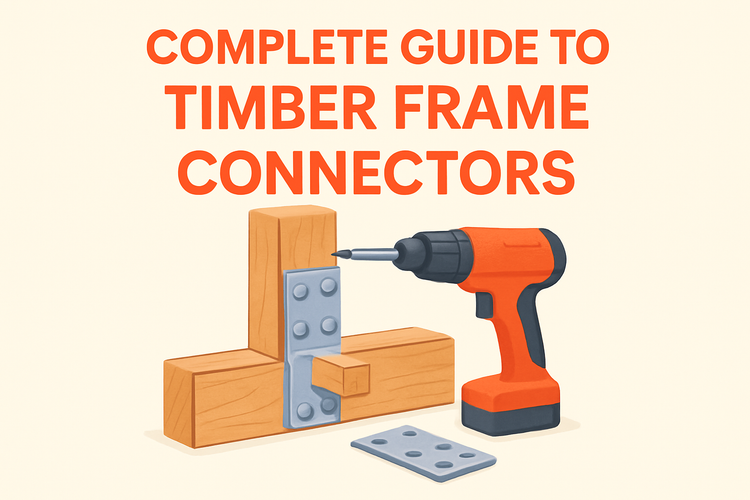Complete Guide To Timber Frame Connectors In Construction

Understanding the Role of Timber Frame Connectors in Modern Construction
Timber frame connectors are crucial components in modern building projects, offering structural support and ensuring stability across various timber applications. Their growing popularity stems from advancements in engineering and a strong focus on sustainable construction practices.
By providing a reliable mechanical connection between timber elements, connectors help distribute loads evenly and prevent weaknesses caused by stress and shifting. From framing to roofing and even wind resistance systems, connectors act as vital reinforcements. Selecting the appropriate type can significantly influence the safety, durability, and lifespan of a structure. Explore more options in our Timber Frame Connectors category to find suitable solutions for your project.
Types of Timber Frame Connectors and Their Applications
Timber frame connectors come in numerous forms, each engineered for specific use cases. Understanding these types helps builders choose the right mechanism that complements the design and integrity of a timber-framed structure. From anchoring vertical posts to supporting joists and cross-beams, the functionality varies widely based on individual project requirements.
For instance, Joist Hangers are commonly used in floors and ceilings to securely hold timber joists in place, thereby distributing load and preventing sagging or disconnections over time. Post Bases, on the other hand, provide a critical interface between vertical timber posts and concrete slabs or foundations, offering moisture protection and anchorage.
When dealing with more complex assemblies such as engineered wood products, specialized connectors are required. This includes connectors for Glulam Timber or Cross Laminated Timber, each tailored for structural systems that demand superior strength and architectural finishes. These elements also offer increased precision and reliability in high-performance construction environments.
In areas prone to harsh environmental conditions, High Wind Ties & Timber Connectors deliver additional reinforcement. These are specifically designed to counteract uplift and lateral forces caused by high winds or seismic events. By using the variety available in our High Wind Connectors section, builders can significantly enhance a structure’s resistance and stability.
Choosing the Right Connector for Durability and Load Requirements
The selection process for timber frame connectors must consider load-bearing capabilities, environmental conditions, wood species, and intended application. Failing to choose a connector that aligns with these parameters can lead to structural failure or excessive wear.
For heavy load applications, such as beams and girder-loaded intersections, Angle Brackets provide robust reinforcement, particularly at angled joints or corners. These components are also designed for bracing elements that require consistent alignment and pressure resistance. Angle Brackets are ideal for both interior and exterior timber contact points, especially in larger framework designs.
Corrosion resistance is another essential factor. Connectors used in outdoor or high-humidity areas, like Roof Connectors, must be manufactured from galvanized or stainless steel to ensure longevity. Similarly, when timber interfaces with masonry, utilizing appropriate Masonry Connectors and Wall Ties enhances the integration of mixed materials while maintaining structural cohesion.
Ultimately, testing loads and understanding building codes relevant to your zone determine much of your selection. Proper engineering analysis is recommended for multi-story buildings that rely on multiple connector types functioning collectively.
Installation Best Practices and Common Mistakes to Avoid
Proper installation of timber frame connectors is vital to achieving the structural integrity they are designed to offer. Even the strongest connector can fail if fixed incorrectly or paired with incompatible materials.
Start by ensuring accurate measuring and cutting of timber parts so that each connector fits snugly without stress. Pre-drilling often helps prevent wood splitting, especially in dense species. Always use manufacturer-approved screws and nails to maintain connector efficacy and avoid galvanic reaction or structural decay between timbers and fasteners.
A common mistake is overloading connectors or ignoring axial load limits. This can lead to shear failures or permanent deformation. Installers should also monitor torque settings when using screw-based connectors to maintain load-bearing capabilities without compromising thread engagement.
Additionally, environmental gaps such as improper sealing between external components and fixings may lead to water ingress and long-term degradation. Treating timber and using raised post bases can protect against ground moisture, insect activity, and mold. Referencing the manufacturer installation guide and local structural codes ensures long-term compliance and durability.
Integrating Safety and Efficiency into Timber Build Systems
Incorporating connectors into timber frame systems goes beyond structural support—it’s about creating efficient, safe, and scalable construction methodologies. The right connector systems can cut down labor costs, speed up installation, and enhance the modularity of prefabricated elements.
Prefabrication, combined with engineered timber like Glulam or CLT, makes integration of connectors critical in design-phase planning. Using pre-mounted Connectors for Cross Laminated Timber panels improves on-site productivity and reduces human error. By standardizing connection points, builders can ensure faster assembly with minimal corrections.
Safety guidelines also stress load testing and periodic inspections of structural joints, especially in high-load areas or regions known for fluctuating weather patterns. Systems like Restraint Straps offer extra precautions by connecting structural elements laterally to prevent overturning during high winds or impact stress.
Ultimately, integrating the right timber connectors enhances a building's performance by balancing strength, elasticity, and ease of assembly. With evolving architectural needs and environmental standards, timber connectors are now foundational to both small timber homes and large commercial wood structures.
